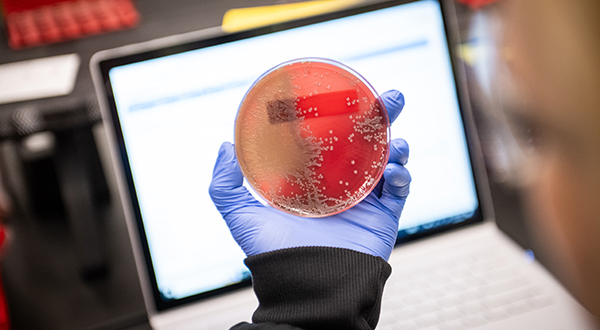Where the bison roam
Biologists are protecting and preserving bison and their prairie home
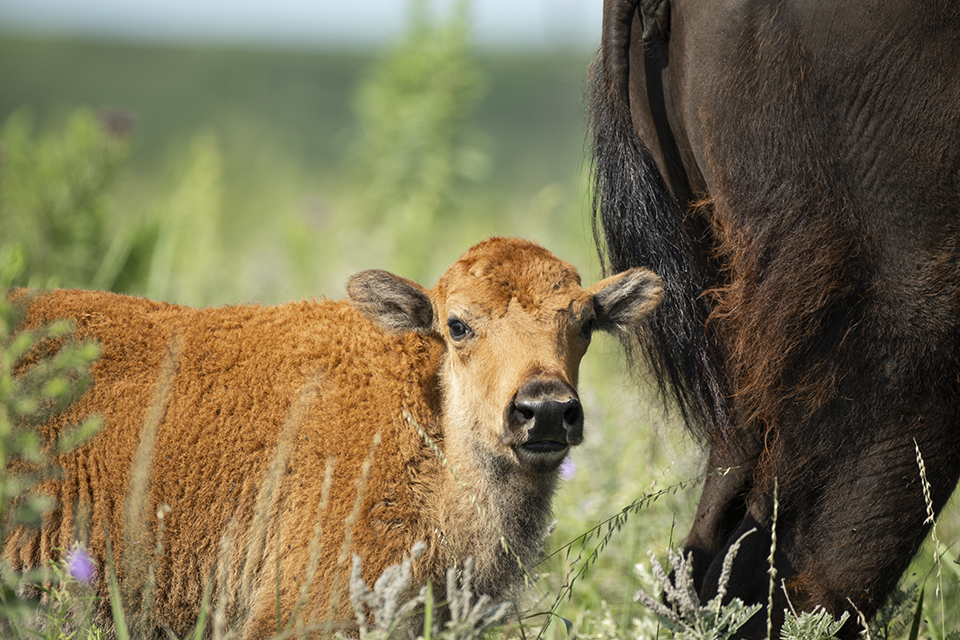 K-State biologists, through efforts at the Konza Prairie Biological Station and in related fields, are working to preserve a prairie home for the bison to forever roam.
K-State biologists, through efforts at the Konza Prairie Biological Station and in related fields, are working to preserve a prairie home for the bison to forever roam.
 By Taylor Provine
By Taylor Provine
K-State News and Communications Services
Press play to listen to a soundscape of bison at the Konza Prairie Biological Station.
This used to be their home.
Before European colonization and before the Kansas State Agricultural College was founded as the nation’s first operational land-grant institution, bison were both the most widespread and the most abundant large animal in North America. But they were nearly driven to extinction.
By the time the Kansas Legislature renamed the college Kansas State University in 1959, bison hadn’t lived in the area for almost a century.
Then they returned.
The Konza Prairie Biological Station, an 8,600-acre native tallgrass prairie, has been a site for long-term ecological research, education and prairie conservation since 1971. In 1987, bison were reintroduced to the Konza Prairie, and have been part of the station’s ecological research program ever since.
K-State researchers are working to understand how the large, widespread animal affected the prairie ecosystem — when they were common, after they were nearly eradicated and now that the bison are returning, albeit in smaller numbers.
They’re working to preserve a prairie home for the bison to forever roam.
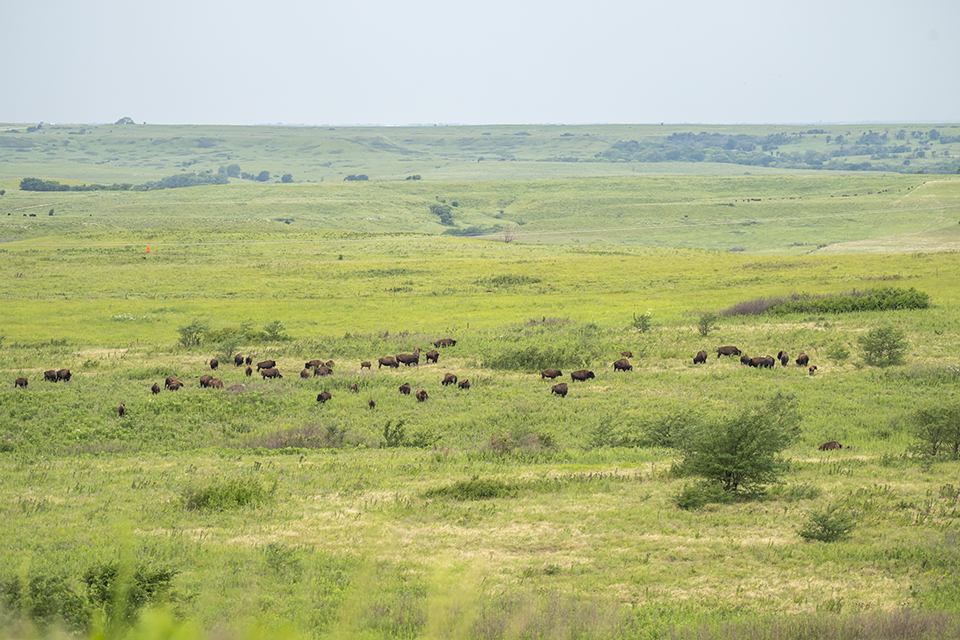 Once numbering in the millions across the Great Plains, bison were nearly driven to extinction as pioneers, trappers and traders killed them — often for sport. K-State biologists are researching ways to support the gentle grazers and preserve their home.
Once numbering in the millions across the Great Plains, bison were nearly driven to extinction as pioneers, trappers and traders killed them — often for sport. K-State biologists are researching ways to support the gentle grazers and preserve their home.
Bison-built landscapes
Bison are important to the prairie because they were one of the large animals that played a part in shaping the landscape.
Understanding them, then, is important to understanding the future of the prairie.
A study led by Zak Ratajczak and Allison Louthan, both assistant professors of biology in the College of Arts and Sciences in the Division of Biology, is looking at ways in which the prairie — in the presence of bison — is affected by climate change and drought.
“Computer simulations of future climate in the central United States and Kansas in general suggest that we will be looking at more frequent droughts and when they occur, will likely last much longer,” Ratajczak said.
Researchers are trying to determine how the prairie ecosystem — particularly through plant biomass that is grazed, at least by bison — will respond to climate change.
“It’s important to know the effect of that, hopefully before this kind of drought happens,” Ratajczak said
 Large enough for bison to pass through, these structures on the Konza Prairie simulate drought, with a partially open roof.
Large enough for bison to pass through, these structures on the Konza Prairie simulate drought, with a partially open roof.
To study and replicate that climate change, Ratajczak and Louthan are building large structures out on the prairie to simulate a lack of rainfall, or drought. These structures have partially covered roofs but are otherwise open on the sides to allow the bison to pass through.
Other research sites have used these types of structures for climate change research, but in ungrazed areas. K-State’s research is the first of its kind at this scale, helping to determine the practical aspects of conducting such studies with bison and other large animals.
“The Konza Prairie tests how the presence of these mega grazers and fire affect the prairie,” Louthan said. “Konza is a leader in developing the theory about how grasslands all over the globe are maintained over time.” 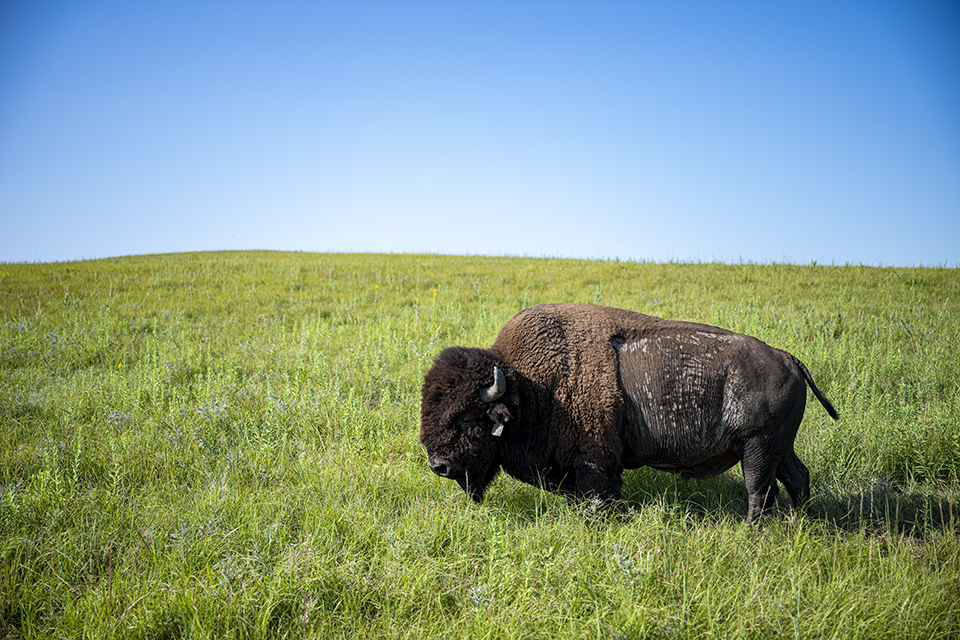
The long-term goal of the project is to discover ways in which the prairie adapts to climate change. Ratajczak is particularly interested in addressing several unanswered questions on exactly how much of the prairie ecosystem changes. For example, does climate change substantially decrease the amount of forage for grazers? Does the amount of biodiversity decrease?
The researchers have observed that when bison are in an area, some of the smaller grasses are more abundant. This is important because the smaller grasses are more common in more heavily droughted areas to the west where there is less precipitation.
“It’s very possible that adding bison into a system could actually make it more able to cope with drought because grazed areas have higher densities of these grass species that are really good at handling drought,” Louthan said.
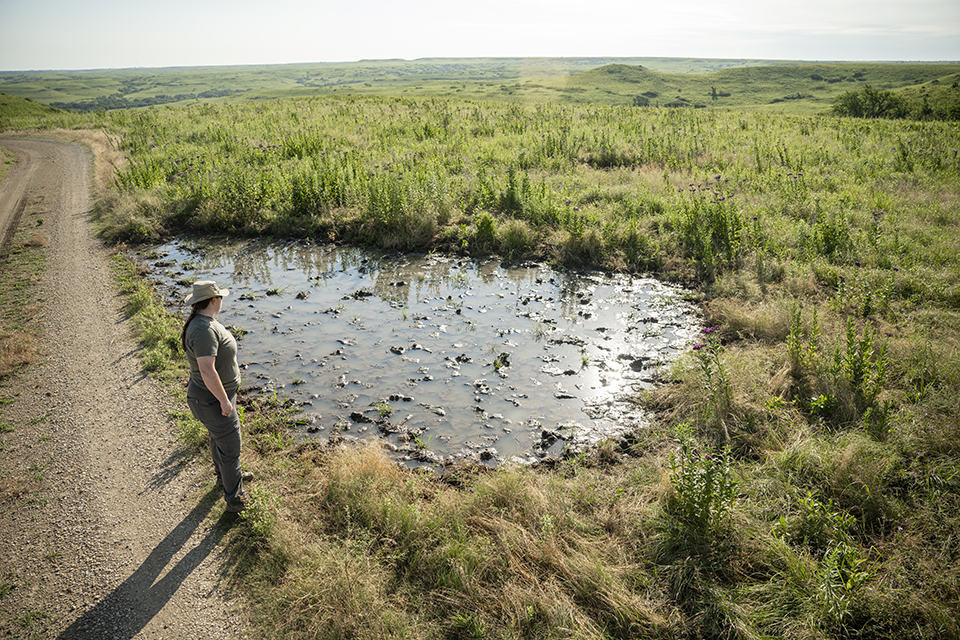 Bess Bookout, doctoral student in biology, overlooks a bison wallow that has filled with rain water. Either dry or wet, these depressions in the ground create miniature ecosystems that support a wide variety of life.
Bess Bookout, doctoral student in biology, overlooks a bison wallow that has filled with rain water. Either dry or wet, these depressions in the ground create miniature ecosystems that support a wide variety of life.
In the shallows of a wallow
On a superficial level, the prairie is resplendent in more than 600 species of tall grasses, wildflowers and other plant life.
But hidden in this flora are the fauna comprised of dozens of species of fish, amphibians, reptiles and mammals. They form an interconnected web of smaller, but no less important, ecosystems, including the bison wallow.
Bison wallows — round, dusty, large depressions in the prairie — are created when the large animals roll in the dirt repeatedly in the same area. As the soil compresses, it makes a shallow bowl, and some wallows collect water as it rains.
Eva Horne, teaching professor of biology and assistant director of the Konza Prairie Biological Station, is studying bison wallows and where bison create them in relation to where they spend their time.
“If we want to understand the North American grasslands, we need to understand the grazers that evolved here with our grassland,” Horne said. “By understanding what they do now, maybe we can understand what the prairies were like long ago.”
“If we want to understand the North American grasslands, we need to understand the grazers that evolved here with our grassland.”
Horne recently published an article that shows the wallows are most concentrated on low slopes, or flat surfaces, at higher elevations with higher rates of fire. These spots are where the bison also spend most of their time.
She’s also studying other organisms that use the wallows.
“There are at least three species of frogs that breed in the wallows, and numerous different insects and arthropods can be found in them,” Horne said. “It changes the diversity of the plants around the wallows, even when they’re dry, because sometimes annual species of plants that don’t have any other place to live can grow in those wallows.”
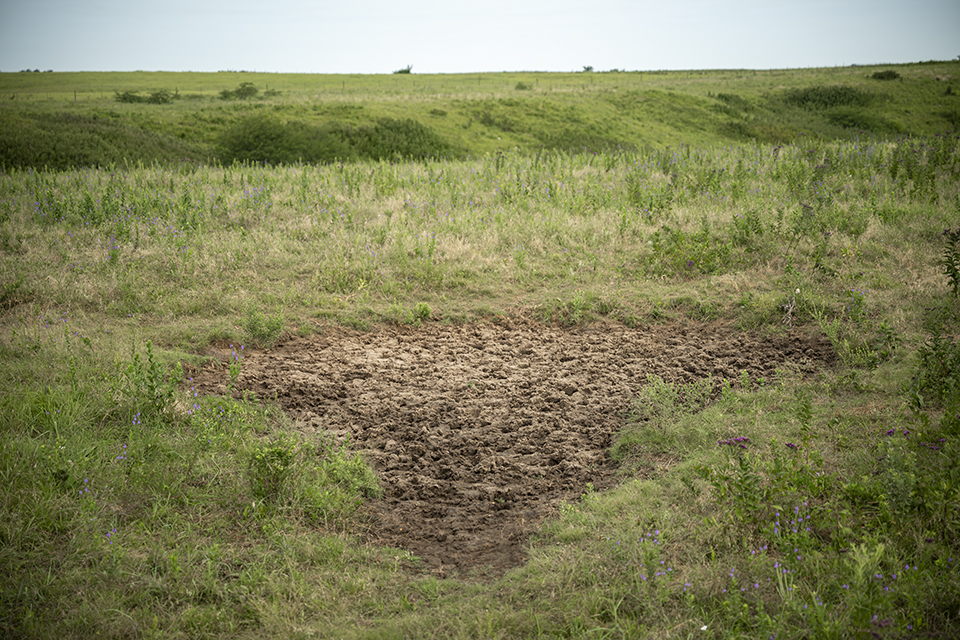 Bison wallows are round, often dusty, large depressions in the prairie that are created when bison roll repeatedly in the dirt.
Bison wallows are round, often dusty, large depressions in the prairie that are created when bison roll repeatedly in the dirt.
Although it is not precisely known why bison wallow, some common hypotheses are that they use the dust to keep insects off or help shed their winter fur, Horne said. But these reasons might not be as important as the effects on the prairie around them.
“They create the wallows, and they destroy cedar trees,” Horne said. “They don’t stand in and mess up streams because they get most of their water from what they eat and the rainfall that collects in the wallows.”
They’re keepers of the prairie.
“Bison are a keystone species — they change the environment and increase the diversity of the other organisms that live on the prairie,” Horne said.
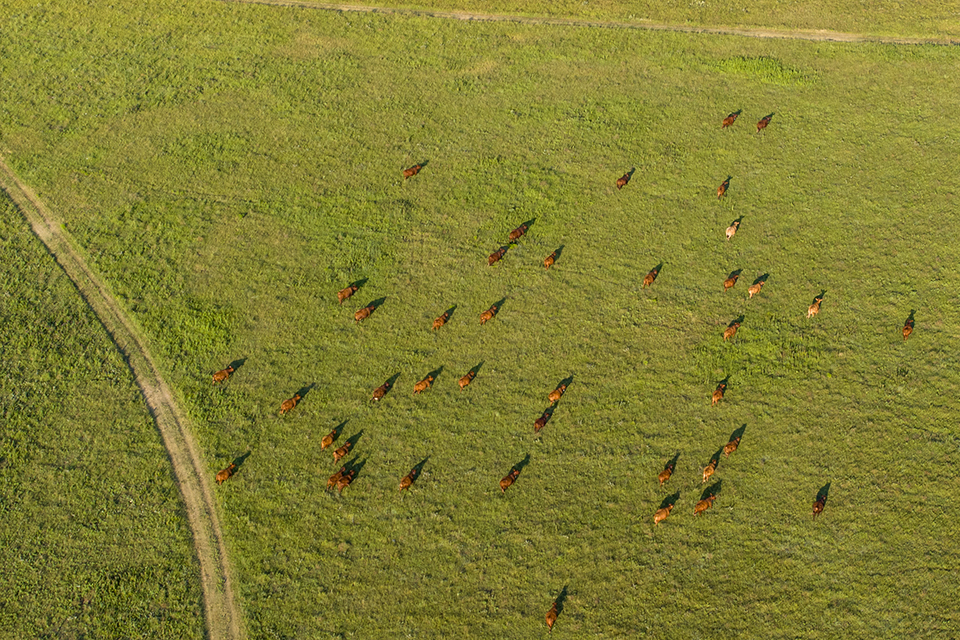
Great grazers
Bison were the original grazers of the prairie. Their grazing was important to the prairie’s ecosystem and its biodiversity. But as the bison were slowly eradicated, so were other species, such as certain populations of tallgrass birds.
To study the current effects of grazing on the prairie, researchers are studying another widespread, large ruminant — cattle — that is the nearest living relative of bison and grazes the prairie in much the same way bison once did.
Alice Boyle, professor of biology, and Walter Dodds, university distinguished professor of biology, are part of a multi-partner project — including The Nature Conservancy, the National Park Service, Kansas Grazing Lands Coalition and private producers — using virtual fencing to control where cattle graze to study grassland bird populations and streams in the Flint Hills of Kansas.
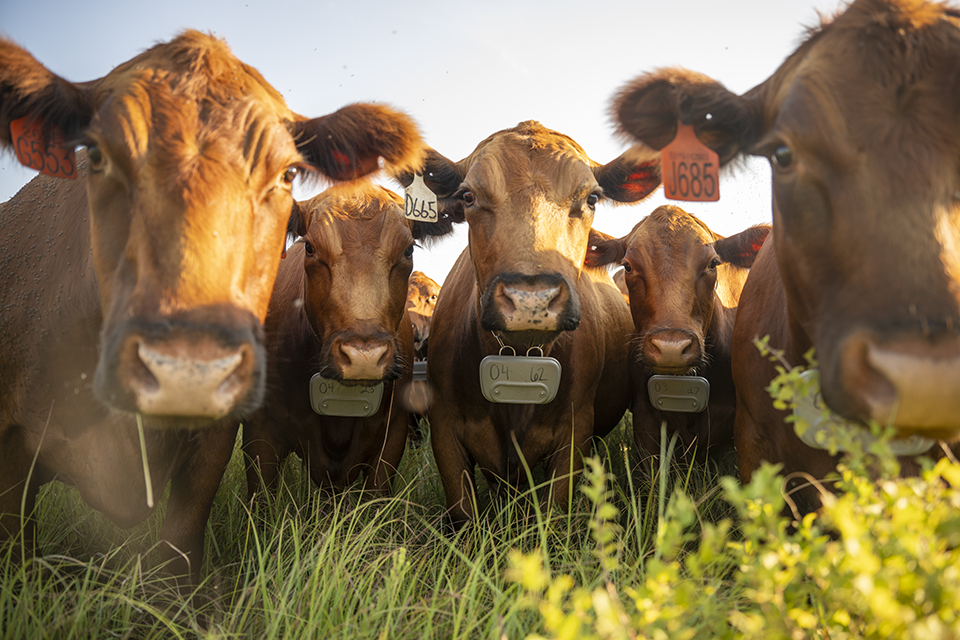 Cattle wearing special GPS collars.
Cattle wearing special GPS collars.
The study is using special cattle collars and advanced GPS tracking to create areas where the cattle can and cannot graze without the need for physical fences, which can be expensive and hard to move to accommodate cattle operations.
According to Boyle, when cattle are kept from grazing in certain areas, vegetation can grow taller and denser.
“It’s the variability that we’re going for,” Boyle said. “With this project we are trying to push the habitat in different ways to create the kinds of conditions that we think are going to benefit the grassland bird populations in general. The species that are being forced out are globally disappearing, and I think it’s our duty to do something about that.”
Areas of taller, denser vegetation are needed because they provide a nesting refuge for prairie chickens and other threatened birds. Prairie chickens create their nests on the ground and without tall vegetation, their nests are unprotected, leaving them vulnerable to predators, Boyle said.
“The species that are being forced out are globally disappearing, and I think it’s our duty to do something about that.”
Another important part of the study is testing how virtual fencing might protect vegetation near the waterways of the Flint Hills.
These riparian zones — the areas bordering bodies of water — are important for maintaining water quality and quantity because the plants within them intercept sediment and nutrient pollution that can come from cattle operations.
“Other studies don’t take place in whole watersheds,” Dodds said. “What happens upstream will influence downstream waters. Our study has two watersheds where cattle can access the whole watershed and graze. Then we have a separate two where we have the virtual fences, keeping most of the animals out of the water and away from the streams.”
The overarching goal of this study is preserving the biodiversity of the prairie. Prairie streams have their own unique organisms, and some are endangered species, Dodds said.
“If the water quality is bad, then your chances of preserving the organisms that rely on the waterways is as well,” Dodds said.

